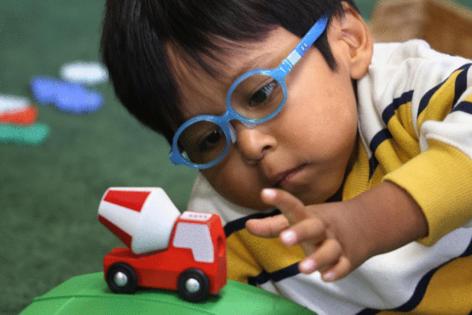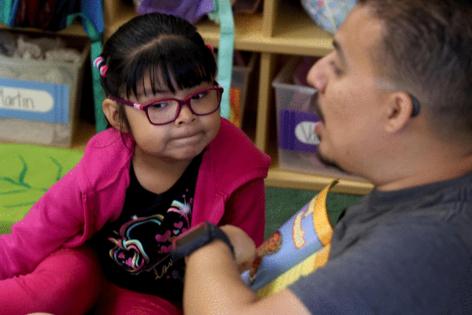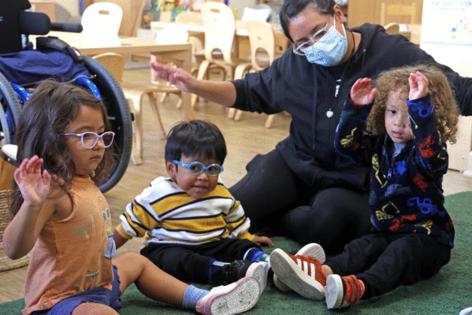Light boxes, braille writers and smell: How this child care center serves visually impaired kids
Published in Lifestyles
LOS ANGELES -- In Saul Valdivia's preschool classroom, a neon green light emanates from underneath the opaque surface of a wooden table. An assortment of plastic bugs and wooden shapes lay scattered across its surface. This light box learning tool uses contrasts to help encourage young kids with impaired vision develop awareness of objects, light and color.
A braille writer and magnifying device across the classroom are ready to be used. And the lights in the room are sometimes turned off or dimmed to accommodate some students' light sensitivity.
The specialized classrooms at the Blind Children's Center in East Hollywood play an outsized role in Los Angeles County, serving as a regional source of child care and early education for infants, toddlers and preschoolers with visual impairments.
More than 11,000 children under age 11 in the county are visually impaired and the center is equipped to address their needs — lessons incorporate smell and touch and include real objects like apples and pumpkins rather than plastic toys. Children with low vision participate in pre-braille learning exercises.
Educational support for youngsters with visual impairments, which are largely under-diagnosed among children under age 5, requires highly individualized learning plans to avoid potential development delays. As a school with Head Start and Early Head Start, the center can serve any L.A. County child with a visual impairment regardless of income.
"We're in an area that's lacking," Chief Executive Officer Sarah Orth said. "And we have those experts on our staff that can support the children and support the curriculum."
The center, which was founded in 1938, braids together federal Head Start funds with state preschool and private donations to run its programs. It limits class sizes and provides access to on-site health and disability services to offer a combination of early intervention, early learning and family support. A tenth of the students enrolled in its programs have a visual impairment.
Adapting early learning
Often families don't know the full extent of their child's impairment when they first arrive at the Blind Children's Center, Orth said. Vision screenings help identity their needs.
A child may be legally blind or have low vision, but their conditions vary. Some may struggle to see color, others might struggle with light perception, said Rosalinda Mendiola, an adaptive services specialist.
When Meredith Sun's son Oscar attended the center several years ago, he learned to navigate his classroom by touch. He would find his cubby based on its proximity to the mat laid out on the floor, and he knew where to sit during circle time because he could feel a mark on the rug.
"They wouldn't move the chairs around without telling Oscar," she said, recalling her son's time at the center. "They would have Oscar feel the classroom where they're going, and they'd have mats or just different textures on the floor."
Mendiola helps teachers and staff customize curriculum. Sometimes a child might benefit from sitting near the teacher, having lighting adjusted or fonts enlarged or changed to a different color. They also may need assistance in orientation, mobility and navigating spaces.
Children who will learn braille start preparing with pre-braille. They may learn to track lines and identify shapes, become familiar with touching braille in books and work on finger strengthening with Play-Doh or by pushing keys on a braille writer.
Parents are also taught how to help their child, Mendiola said. She instructs families to narrate their actions, such as by sharing with their child when they slow down at a stoplight on the way back from school.
Building an inclusionary support system
"Bravo," cheers a physical therapist as she stands next to preschooler named Baruc who sits in a wheelchair during outdoor free play. The child tosses a soccer ball at three plastic bowling pins gathered in front of him, knocking down two. Another child eagerly chases the ball and returns it to him for another try, pointing to his remaining target.
"Everything's done together — that's part of the inclusion process," Orth said. "Everyone's doing it at their level, whatever it is. It's everyone together in their own way."
The center's inclusive approach keeps students learning alongside typically developing children, integrating services such as physical and occupational therapy into the children's regular activities and playtime.
Approximately 40% of enrolled students have a disability, Orth said, compounding the need for specialized support.
"It's very hard for families to find preschool programs that can accommodate all of the various challenges that they might have," she said. "Oftentimes kids that have more complex disabilities — they are very isolated. So we're really wanting to build that community."
Staff also provide mental health counseling to families and visit students in the hospital when they undergo surgery. And the center hosts education classes and support groups for parents to help them navigate the influx of information and overcome some of the cultural stigma associated with vision loss by encouraging acceptance.
For Meredith Sun, having classes with both visually impaired and non-visually impaired students on such a small scale at the center helped prepare her son Oscar for public school, where his second-grade class has 21 students and he is the only child who is blind.
"His character just developed," Sun said about Oscar's time at the center several years ago. "He's not shy anymore. He looks forward to playing with other kids and playing with the teachers, having silly jokes, sharing his stories at home and with the teacher."
Part of learning is also getting children to understand how to navigate their environment, Mendiola said. Take the outdoor play area. There, grass meets rubber playground flooring meets concrete. Wooden benches and trees accent the terrain alongside giant Legos and mini soccer goals.
Not only do these objects diversify the play area, but they provide obstacles for some of the kids to navigate. It's a chance for them to learn how to adapt to surroundings that emulate the challenges of the world outside the center.
If they bump into something, that's OK, said Mendiola, who is visually impaired. It's part of the learning experience.
____
This article is part of The Times' early childhood education initiative, focusing on the learning and development of California children from birth to age 5. For more information about the initiative and its philanthropic funders, go to latimes.com/earlyed .
©2025 Los Angeles Times. Visit at latimes.com. Distributed by Tribune Content Agency, LLC.





























Comments